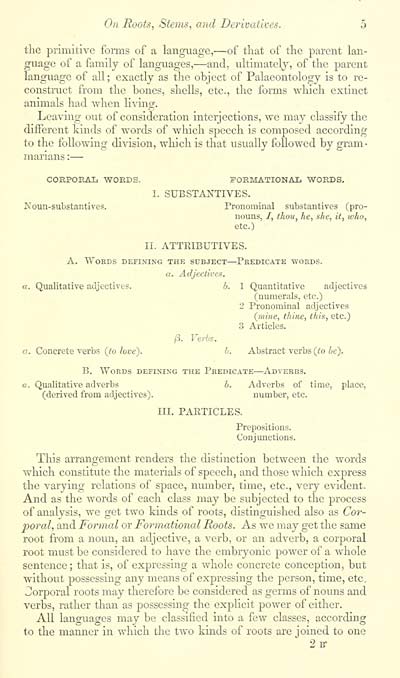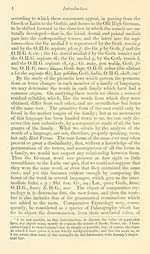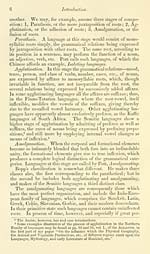Blair Collection > Celtic studies
(35)
Download files
Complete book:
Individual page:
Thumbnail gallery: Grid view | List view

On Roots, Stems, and Derivatives. 5
the primitive fomis of a language, — of that of the parent lan-
guage of a family of languages, — and, ultimately, of the parent
language of all; exactly as the object of Palaeontology is to re-
construct from the bones, shells, etc., the forms which extinct
animals had when livuig.
Leaving out of consideration interjections, we may classify the
different kinds of words of which speech is composed according
to the following division, which is that usually followed by gram-
marians : —
CORPOEAL WORDS. FORMATIONAL WORDS,
I. SUBSTANTIVES.
Noun-substantives. Pronominal substantives (pro-
nouns, /, thou, he, she, it, who,
etc.)
II. ATTEIBUTIVES.
A. Words defining the subject — Predicate words.
a. Adjectives.
a. Qualitative adjectives. 6. 1 Quantitative adjectives
(numerals, etc.)
2 Pronominal adjectives
(niine, thine, this, etc.)
3 Articles.
13. Verbs.
a. Concrete verbs (to love). b. Abstract verbs {to he).
B, Words defining the Predicate — Adverbs.
o. Qualitative adverbs b. Adverbs of time, place,
(derived from adjectives). number, etc.
III. PARTICLES.
Prepositions.
Conjunctions.
This arrangement renders the distinction between the words
which constitute the materials of speech, and those which express
the varying relations of space, number, time, etc., very evident.
And as the words of each class may be subjected to the process
of analysis, we get two kinds of roots, distinguished also as Cor-
poral, and Formal or Formational Roots. As we may get the same
root from a noun, an adjective, a verb, or an adverb, a corporal
root must be considered to have the embryonic power of a whole
sentence ; that is, of expressing a whole concrete conception, but
without possessing any means of expressing the person, time, etc.
Jorporal roots may therefore be considered as germs of nouns and
verbs, rather than as possessing the explicit power of either.
All languages may be classified into a few classes, according
to the manner in which the two kinds of roots are joined to one
28"
the primitive fomis of a language, — of that of the parent lan-
guage of a family of languages, — and, ultimately, of the parent
language of all; exactly as the object of Palaeontology is to re-
construct from the bones, shells, etc., the forms which extinct
animals had when livuig.
Leaving out of consideration interjections, we may classify the
different kinds of words of which speech is composed according
to the following division, which is that usually followed by gram-
marians : —
CORPOEAL WORDS. FORMATIONAL WORDS,
I. SUBSTANTIVES.
Noun-substantives. Pronominal substantives (pro-
nouns, /, thou, he, she, it, who,
etc.)
II. ATTEIBUTIVES.
A. Words defining the subject — Predicate words.
a. Adjectives.
a. Qualitative adjectives. 6. 1 Quantitative adjectives
(numerals, etc.)
2 Pronominal adjectives
(niine, thine, this, etc.)
3 Articles.
13. Verbs.
a. Concrete verbs (to love). b. Abstract verbs {to he).
B, Words defining the Predicate — Adverbs.
o. Qualitative adverbs b. Adverbs of time, place,
(derived from adjectives). number, etc.
III. PARTICLES.
Prepositions.
Conjunctions.
This arrangement renders the distinction between the words
which constitute the materials of speech, and those which express
the varying relations of space, number, time, etc., very evident.
And as the words of each class may be subjected to the process
of analysis, we get two kinds of roots, distinguished also as Cor-
poral, and Formal or Formational Roots. As we may get the same
root from a noun, an adjective, a verb, or an adverb, a corporal
root must be considered to have the embryonic power of a whole
sentence ; that is, of expressing a whole concrete conception, but
without possessing any means of expressing the person, time, etc.
Jorporal roots may therefore be considered as germs of nouns and
verbs, rather than as possessing the explicit power of either.
All languages may be classified into a few classes, according
to the manner in which the two kinds of roots are joined to one
28"
Set display mode to: Large image | Transcription
Images and transcriptions on this page, including medium image downloads, may be used under the Creative Commons Attribution 4.0 International Licence unless otherwise stated. ![]()
| Early Gaelic Book Collections > Blair Collection > Celtic studies > (35) |
|---|
| Permanent URL | https://digital.nls.uk/75771567 |
|---|
| Description | A selection of books from a collection of more than 500 titles, mostly on religious and literary topics. Also includes some material dealing with other Celtic languages and societies. Collection created towards the end of the 19th century by Lady Evelyn Stewart Murray. |
|---|
| Description | Selected items from five 'Special and Named Printed Collections'. Includes books in Gaelic and other Celtic languages, works about the Gaels, their languages, literature, culture and history. |
|---|

